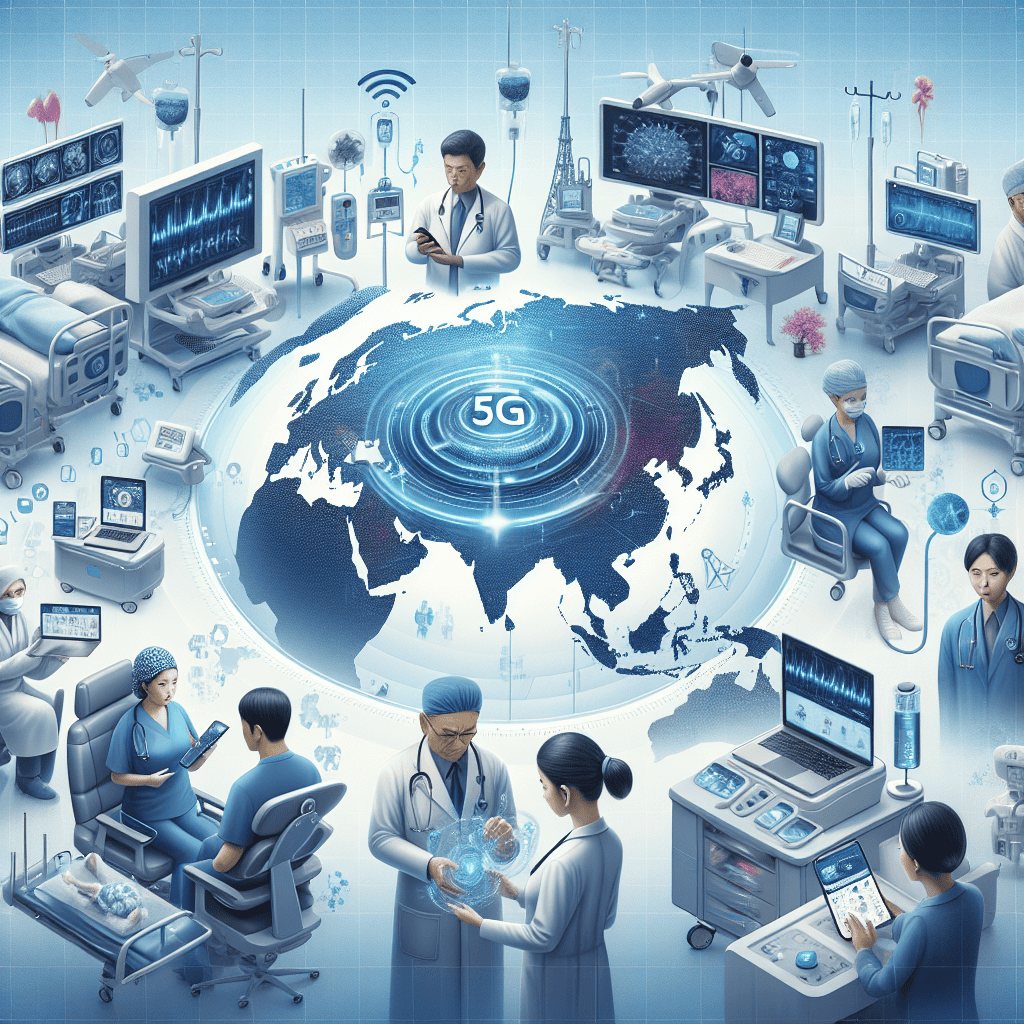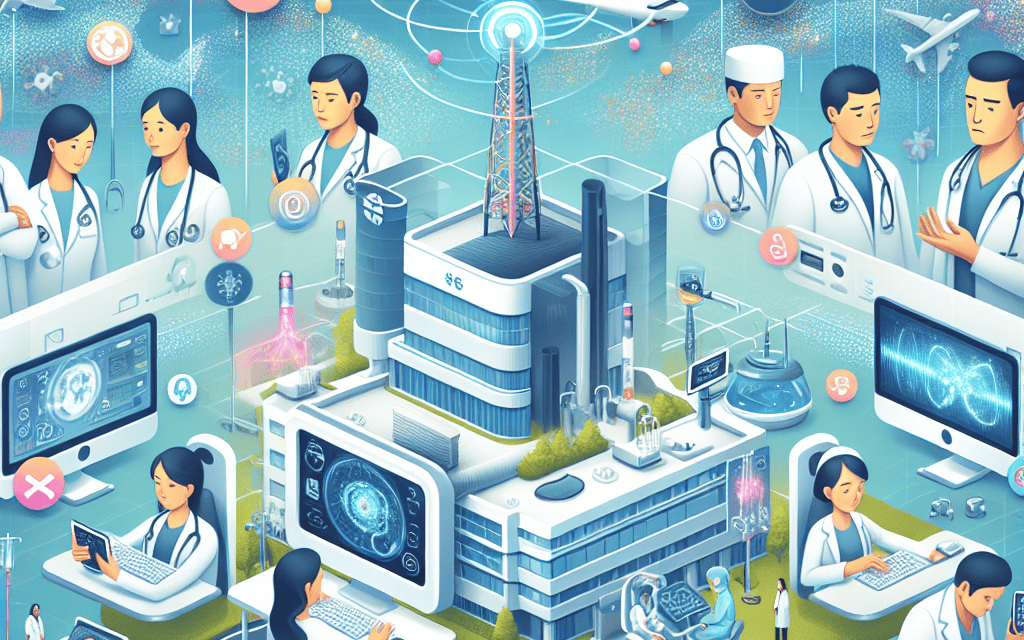5G: Transforming Healthcare’s Future in the Asia-Pacific Region

The advent of 5G technology is poised to revolutionize various sectors, with healthcare being one of the most promising areas for transformation. In the Asia-Pacific region, where diverse healthcare challenges exist, 5G offers unprecedented opportunities to enhance medical services, improve patient outcomes, and streamline healthcare operations. This article delves into how 5G is set to transform healthcare in the Asia-Pacific region, exploring its potential impacts, challenges, and future prospects.
1. Enhancing Telemedicine and Remote Patient Monitoring
Telemedicine has been a growing trend in healthcare, especially in the wake of the COVID-19 pandemic. The introduction of 5G technology is expected to significantly enhance telemedicine services by providing faster, more reliable, and higher-quality connections. This is particularly crucial in the Asia-Pacific region, where geographical barriers often limit access to healthcare.
5G’s low latency and high-speed connectivity enable real-time video consultations, allowing healthcare providers to diagnose and treat patients remotely with greater accuracy. This is especially beneficial in rural and remote areas where access to healthcare facilities is limited. For instance, in countries like India and Indonesia, where vast populations reside in rural areas, 5G can bridge the gap between patients and healthcare providers.
Moreover, 5G facilitates advanced remote patient monitoring systems. Wearable devices and IoT-enabled health sensors can continuously collect and transmit patient data to healthcare providers, enabling proactive management of chronic conditions. This real-time data transmission allows for timely interventions, reducing hospital readmissions and improving patient outcomes.
Case studies from South Korea and Japan demonstrate the potential of 5G in telemedicine. In South Korea, 5G-enabled telemedicine services have been implemented in remote islands, providing residents with access to specialist consultations without the need for travel. Similarly, Japan has leveraged 5G to develop advanced telehealth platforms that offer high-definition video consultations and remote diagnostics.
- Real-time video consultations with low latency
- Advanced remote patient monitoring systems
- Improved access to healthcare in rural and remote areas
2. Revolutionizing Medical Imaging and Diagnostics
Medical imaging and diagnostics are critical components of modern healthcare. The integration of 5G technology is set to revolutionize these areas by enabling faster and more accurate imaging processes. In the Asia-Pacific region, where healthcare systems are often burdened by high patient volumes, 5G can significantly enhance diagnostic capabilities.
5G’s high bandwidth allows for the rapid transmission of large imaging files, such as MRI and CT scans, to specialists for analysis. This reduces the time required for diagnosis and enables quicker treatment decisions. In countries like China and Australia, where healthcare facilities are often centralized in urban areas, 5G can facilitate remote diagnostics, allowing specialists to review images from distant locations.
Furthermore, 5G supports the development of AI-powered diagnostic tools. These tools can analyze medical images with high precision, assisting radiologists in identifying abnormalities and improving diagnostic accuracy. In Singapore, for example, AI-driven diagnostic platforms are being integrated with 5G networks to enhance the speed and accuracy of cancer detection.
The use of 5G in medical imaging is also being explored in the context of mobile imaging units. These units can be deployed in disaster-stricken areas or regions with limited healthcare infrastructure, providing on-the-spot imaging services. This capability is particularly valuable in the Asia-Pacific region, which is prone to natural disasters.
- Rapid transmission of large imaging files
- AI-powered diagnostic tools
- Mobile imaging units for disaster response
3. Facilitating Robotic Surgery and Advanced Medical Procedures
Robotic surgery and advanced medical procedures are becoming increasingly prevalent in modern healthcare. The introduction of 5G technology is set to enhance these procedures by providing the necessary connectivity for precise and real-time control of surgical robots.
5G’s ultra-low latency is crucial for robotic surgery, where even a slight delay can impact the outcome of a procedure. In the Asia-Pacific region, where there is a growing demand for minimally invasive surgeries, 5G can enable surgeons to perform complex procedures with greater precision and control.
Countries like China and South Korea are at the forefront of integrating 5G with robotic surgery. In China, 5G-enabled robotic surgery systems have been successfully used to perform remote surgeries, allowing specialists to operate on patients from different locations. This capability is particularly valuable in regions with a shortage of skilled surgeons.
Additionally, 5G supports the development of advanced medical procedures, such as telesurgery and augmented reality-assisted surgeries. These technologies allow surgeons to collaborate with specialists worldwide, enhancing the quality of care and expanding access to cutting-edge medical techniques.
The potential of 5G in facilitating robotic surgery and advanced medical procedures is further highlighted by its ability to support real-time data exchange between surgical teams and medical devices. This ensures seamless coordination during complex procedures, reducing the risk of complications and improving patient outcomes.
- Ultra-low latency for precise robotic control
- Remote surgeries and telesurgery capabilities
- Augmented reality-assisted surgeries
4. Improving Healthcare Supply Chain and Logistics
The healthcare supply chain and logistics are critical components of healthcare delivery. The integration of 5G technology is set to transform these areas by enhancing the efficiency and transparency of supply chain operations.
5G’s high-speed connectivity enables real-time tracking of medical supplies and equipment, ensuring timely delivery and reducing the risk of shortages. In the Asia-Pacific region, where healthcare systems often face logistical challenges, 5G can streamline supply chain operations and improve resource allocation.
For instance, in countries like India and Thailand, 5G-enabled supply chain management systems are being developed to optimize the distribution of vaccines and essential medicines. These systems use IoT sensors to monitor the condition and location of medical supplies, ensuring they reach their destination in optimal condition.
Moreover, 5G supports the development of smart healthcare logistics solutions, such as autonomous delivery drones and vehicles. These technologies can be used to transport medical supplies to remote or disaster-stricken areas, ensuring timely access to essential resources.
The use of 5G in healthcare logistics is further enhanced by its ability to support real-time data analytics. This allows healthcare providers to make informed decisions about inventory management and resource allocation, reducing waste and improving operational efficiency.
- Real-time tracking of medical supplies
- Smart healthcare logistics solutions
- Real-time data analytics for inventory management
5. Addressing Challenges and Future Prospects
While the potential of 5G in transforming healthcare in the Asia-Pacific region is immense, several challenges must be addressed to fully realize its benefits. These challenges include infrastructure development, regulatory hurdles, and data security concerns.
Infrastructure development is a significant challenge, as the deployment of 5G networks requires substantial investment in new infrastructure. In many Asia-Pacific countries, existing telecommunications infrastructure may not be sufficient to support widespread 5G adoption. Governments and private sector stakeholders must collaborate to address these infrastructure gaps and ensure equitable access to 5G technology.
Regulatory hurdles also pose a challenge to the adoption of 5G in healthcare. The integration of 5G with medical devices and systems requires compliance with stringent regulatory standards to ensure patient safety and data privacy. Policymakers must work to develop clear and consistent regulations that facilitate the safe and effective use of 5G in healthcare.
Data security is another critical concern, as the increased connectivity enabled by 5G raises the risk of cyberattacks and data breaches. Healthcare providers must implement robust cybersecurity measures to protect patient data and ensure the integrity of healthcare systems.
Despite these challenges, the future prospects of 5G in healthcare are promising. As 5G networks continue to expand across the Asia-Pacific region, new opportunities for innovation and collaboration will emerge. The integration of 5G with emerging technologies such as AI, IoT, and blockchain will further enhance healthcare delivery and improve patient outcomes.
- Infrastructure development and investment
- Regulatory compliance and standards
- Data security and cybersecurity measures
Conclusion
In conclusion, 5G technology holds the potential to transform healthcare in the Asia-Pacific region by enhancing telemedicine, revolutionizing medical imaging, facilitating robotic surgery, improving supply chain logistics, and addressing key challenges. As the region continues to embrace 5G, healthcare providers, policymakers, and technology developers must work together to overcome obstacles and harness the full potential of this transformative technology. By doing so, they can create a more efficient, accessible, and patient-centered healthcare system that meets the diverse needs of the Asia-Pacific population.





